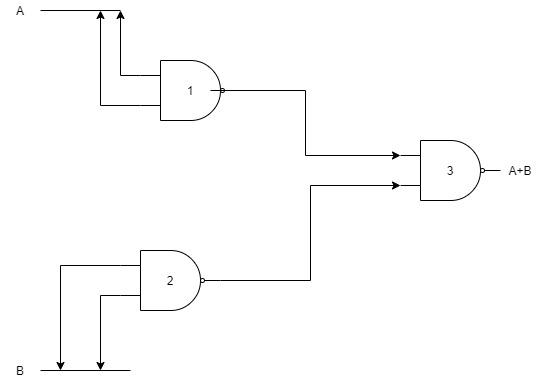
Draw a diagram to show how NAND gates can be combined to obtain an OR gate.
Answer
577.5k+ views
Hint: NAND gate and NOR gate are called universal gates since all simple gates like NOT, AND, and OR gates can be constructed using them. In the NAND gate, the two inputs are multiplied and the inverse is taken of the answer.
If A and B are two inputs to a NAND gate, the output is: $\overline {A.B} $
The formula used for converting NAND gate to OR gate is:
\[\overline {\overline A .\overline B } = A + B\]
Complete step by step solution:
If A and B are two inputs to a NAND gate, the output is: $\overline {A.B} $
To construct an OR gate from NAND gates, we need 3 NAND gates. Let us arrange them as shown in the circuit diagram:

We will analyse the circuit by considering each of the NAND gates.
Step 1: NAND Gate -1
Input for the NAND gate = A and A
NAND operation = \[\overline {A.A} \]
Output = $\overline A $
Step 2: NAND Gate -1
Input for the NAND gate = B and B
NAND operation = \[\overline {B.B} \]
Output = $\overline B $
Step 1: NAND Gate -1
Input for the NAND gate = $\overline A $and $\overline B $
NAND operation =
\[\overline {\overline A .\overline B } = \overline{\overline A} + \overline{\overline B} \]
Since double negative is positive,
\[\overline {\overline A .\overline B } = \overline{\overline A} + \overline{\overline B} = A + B\]
Output = $A + B$
The final output is equivalent to the OR gate:
$A||B = A + B$
$\therefore$Three NAND gates can be used to create an OR gate.
Note:
Sometimes, it becomes difficult to remember the conversion of Universal gates. You can easily remember the whole thing by understanding this mnemonic.
NAND Gate:
To convert to AND gate, first negate together because AND means together and negate the result.

To convert to OR gate, first negate them individually because OR means individually and negate the result.

If A and B are two inputs to a NAND gate, the output is: $\overline {A.B} $
The formula used for converting NAND gate to OR gate is:
\[\overline {\overline A .\overline B } = A + B\]
Complete step by step solution:
If A and B are two inputs to a NAND gate, the output is: $\overline {A.B} $
To construct an OR gate from NAND gates, we need 3 NAND gates. Let us arrange them as shown in the circuit diagram:

We will analyse the circuit by considering each of the NAND gates.
Step 1: NAND Gate -1
Input for the NAND gate = A and A
NAND operation = \[\overline {A.A} \]
Output = $\overline A $
Step 2: NAND Gate -1
Input for the NAND gate = B and B
NAND operation = \[\overline {B.B} \]
Output = $\overline B $
Step 1: NAND Gate -1
Input for the NAND gate = $\overline A $and $\overline B $
NAND operation =
\[\overline {\overline A .\overline B } = \overline{\overline A} + \overline{\overline B} \]
Since double negative is positive,
\[\overline {\overline A .\overline B } = \overline{\overline A} + \overline{\overline B} = A + B\]
Output = $A + B$
The final output is equivalent to the OR gate:
$A||B = A + B$
$\therefore$Three NAND gates can be used to create an OR gate.
Note:
Sometimes, it becomes difficult to remember the conversion of Universal gates. You can easily remember the whole thing by understanding this mnemonic.
NAND Gate:
To convert to AND gate, first negate together because AND means together and negate the result.

To convert to OR gate, first negate them individually because OR means individually and negate the result.

Recently Updated Pages
A man running at a speed 5 ms is viewed in the side class 12 physics CBSE

The number of solutions in x in 02pi for which sqrt class 12 maths CBSE

State and explain Hardy Weinbergs Principle class 12 biology CBSE

Write any two methods of preparation of phenol Give class 12 chemistry CBSE

Which of the following statements is wrong a Amnion class 12 biology CBSE

Differentiate between action potential and resting class 12 biology CBSE

Trending doubts
What are the major means of transport Explain each class 12 social science CBSE

Which are the Top 10 Largest Countries of the World?

Draw a labelled sketch of the human eye class 12 physics CBSE

How much time does it take to bleed after eating p class 12 biology CBSE

Explain sex determination in humans with line diag class 12 biology CBSE

Explain sex determination in humans with the help of class 12 biology CBSE




